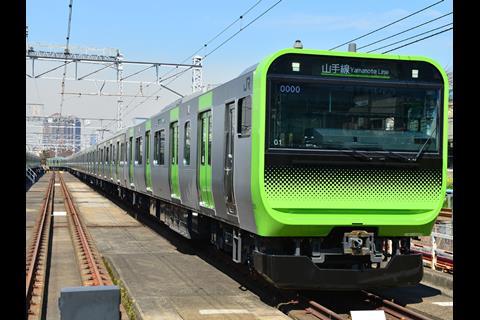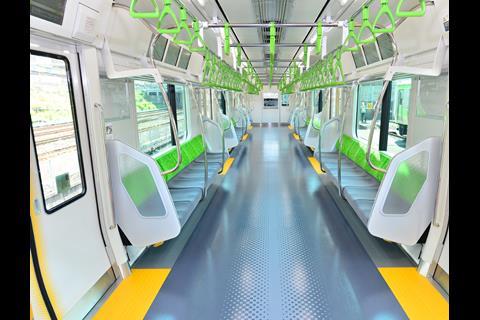JAPAN: East Japan Railway has unveiled a prototype for its next generation of electric multiple-units to operate the 1 067 mm gauge Yamanote Loop around the centre of the capital. This heavily-used 34·5 km circular line serves the main Tokyo Station as well as the key interchange at Shinjuku, which is used by more than three million passengers/day.
Built by J-TREC, the 11-car Series E235 EMU is expected to enter passenger service later this year. It has six motor cars and five trailers, including two driving cars. One intermediate trailer has been re-used from an older Series E231, which has been the mainstay of Yamanote Loop services since replacing the earlier Series 205 units in 2002.
The E235’s stainless-steel bodyshells have been modified from the E231 design to enhance crash energy absorption, while the door operating mechanisms have changed from electric screw to a new type of closer in order to minimise the risk of passengers becoming trapped between the door leaves.
Unlike the E231s which have three married-pairs of power cars, the E235 has six electrically-independent motor cars. These have VVVF invertors with silicon carbide semiconductors, feeding totally-enclosed traction motors with heat-exchanger cooling. For the first time on JR East the unit is equipped with oil-free compressors for the pneumatic systems. Full regenerative braking is provided, and the maximum speed is 120 km/h.
The Series E235 is equipped with real-time condition monitoring and diagnostics, with operational data being continually reported to the control centre and depot.
The interior has LED lighting throughout, including LED advertising displays which will replace the traditional hanging paper advertisements. The seats are 460 mm wide, which is 10 mm wider than those on the E231, but an extra three seats are provided in each vehicle.
The headlights are mounted in a higher position than on the Series E231, so that passengers can see an approaching train above the platform edge doors. These are currently being installed on the Yamanote Loop as part of a programme to reduce peak-hour headways to less than 2 min.








































